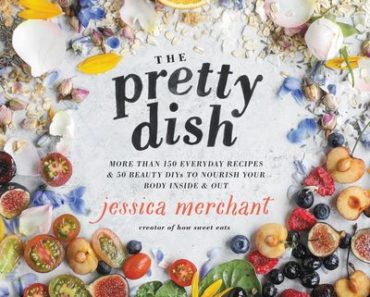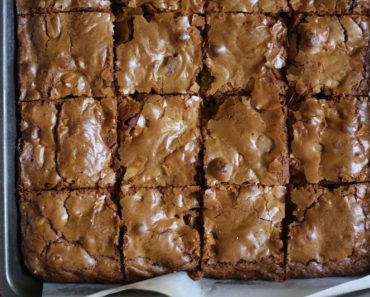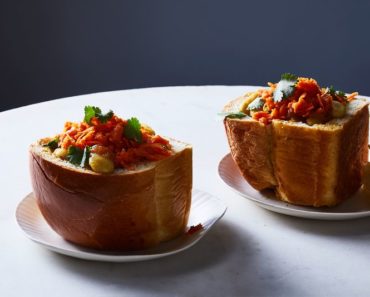Welcome to Spring Clean Your Life, your one-stop shop for gotta-try-those tips & bookmark-me inspiration to spruce up your kitchen and home this season—and well beyond.
I have a fantasy of a completely uniform kitchen, where every scrap of food is stored in a container that coordinates with all the others, where every bag of rice or spice is immediately decanted into something gleaming and glassy and well-labeled. The fantasy looks something like this.
A post shared by Amanda? Vegan Food + Lifestyle (@raw_manda) on Jan 31, 2018 at 3:03pm PST
But every time I buy in too strongly into an organizational daydream, I try to remember to take all this containing stuff with a grain of salt, lest I start echoing this horrifying old Tupperware ad from 1960: “Best thing that happened to women since they got the vote!”
Excepting those who are singularly dedicated to organization, most people live like me, I think, with a mix of containers that work better than others in specific situations. This guide will help you pick your own path as you try to organize your cupboard shelves and get set for leftovers.
The Stacking issue
A while back, I went all in on a glass storage jar system that had slightly rounded lids and it made me a little crazy. Despite the curvature, I kept trying to stack them and ended up with occasional exploding messes as the jars tumbled off one another. If you are going to go more than single height with your pantry containers, make sure they stack securely with their lids on. The best stacking containers for dry storage have very flat lids that are indented from the edge to keep the container above it from getting knocked off. The ultimate cheap version of a stacking container is used all over restaurant kitchens: polypropylene deli containers, which don’t explode into shards even if they do fall. If you have committed to glass containers in your pantry, you can use shelf risers to get some secure height.
There’s also the problem of storing empty containers that are waiting to be filled: If you are limited in drawer height, consider containers that nest like a matryoshka doll: They will take up less space. I like having many containers of my favorite sizes, so I often look for ones that stack into neat little towers inside one another when they are empty, like restaurant-style stainless steel containers (1/6 and 1/9 pans pictured below) that stack snugly inside one another.
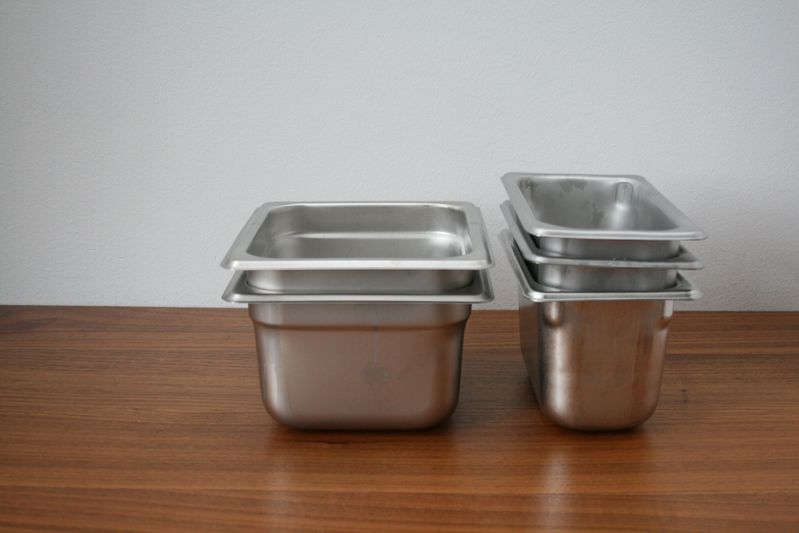
Photo by Sara Dickerman
Square or Rounded?
If you are trying to get the most of every inch of space that you have, then there’s something to be said for corners, like those in my metal pans. Rectangular and square containers just fit better together, and though I use a lot of round containers in my cupboards, I strongly favor squared-off containers for the refrigerator, where I always feel short on space.
Types of Lids
You want all your lids to be secure, but some lids are more important than others: the ones you use for smellier foods (like kimchi or anchovies) and those you use for ferrying liquid-y foods from one place to another. Before you buy a whole suite of containers, test drive one or two pieces. Do something tricky with it, like shaking up a vinaigrette or taking a soup to a potluck in it. If there’s no puddle on the car floor after you’ve gotten there, then consider investing more.
Clamp lids look awesome, and never get lost, but they are a little harder to clean than detachable lids, so they are best for dry storage that doesn’t often get washed.
Speaking of lids, sometimes you don’t need a new container, you just need a lid. You can now get little silicone lids that don’t take a lot of space but can just seal up a baking dish or bowlful of food. No plastic wrap needed. Even easier? Sometimes I’ll just pop a plate on top of a serving bowl of leftovers in the fridge.
Plastic or Glass?
I am trying to reduce the amount of plastic I use in my kitchen, but it’s a tricky payoff. Glass can break, which is why restaurants often hesitate to use it for storage. Stainless steel is gorgeous, but it doesn’t let you shoot a quick eye on the contents—bad news if you are not a conscientious labeler. (I label my stainless containers with masking tape and Sharpies, just like I used to in restaurants.
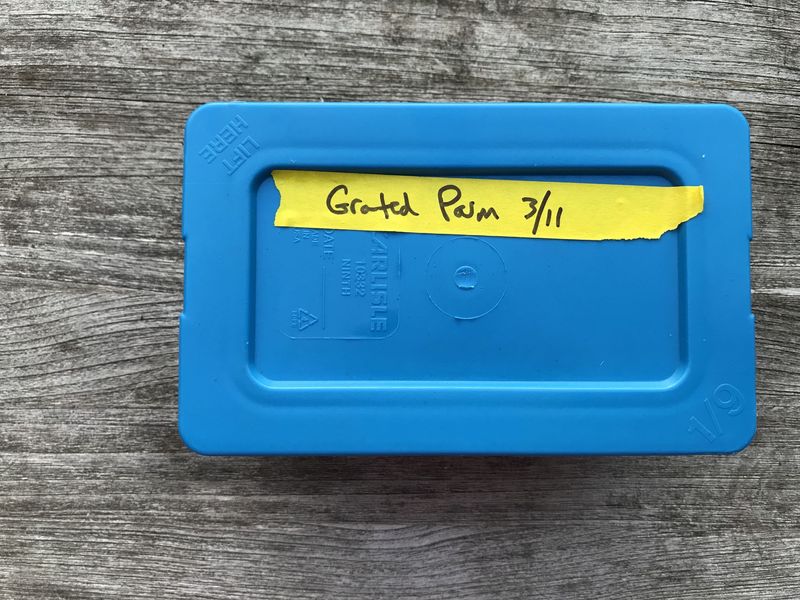
Photo by Sara Dickerman
Most of my food containers are now glass or stainless, but I still lean on a few polypropylene containers for backup (it’s labeled #5 plastic, which is still plastic, but has a higher heat tolerance than other plastics, and seems to be more stable. Still, don’t I treat them as disposable, and I never heat food in them).
Glass is the best inexpensive alternative to plastic, and while jars are a classic, the newer breed of containers with securely locking lids are pretty great for sealing in food. The downside to glass? It’s easy to break, obviously, and because of this, storage of the empty containers can take a lot of space if you’re trying to keep things from crunching into one another. Also, freezing in glass requires a little vigilance. Always leave a little more space for expansion than you think you need when you freeze in glass or the container might burst.
Price
If you are trying to tame your pantry or your leftovers, it is important to keep in mind that you want to be able be ready for the next thing to come up. If you are looking for a way of organizing, make sure it’s a system that you can afford to go deep on, so that you have extra empty containers to transfer new leftovers, or half a bag of pasta, or that open bag of whole wheat flour to. Cheaper prices don’t necessarily mean plastic. If you are trying to be frugal, remember there’s a reason that Mason jars are popular: You can often scoop them up at the thrift store, and you’ll just need to get new lids for them. Also remember how many containers there are to be repurposed. Get your yogurt in big containers instead of individual servings, and reuse the tubs for storage, and a shelf of upcycled Bonne Maman jelly jars are very winning with their gingham tops.
Attractive or functional?
If the stuff you are storing is going to be on a counter or an open shelf, cuteness is a reasonable priority, too. There are countless adorable vintage containers for this sort of thing, from mod and declarative to country cute to, well, French. Which can all be good if you are storing these regularly used ingredients on your countertop. The problem with vintage containers is: 1) They are often too narrow in the opening for dipping in measuring tools, and 2) Unless you are talking Jonathan Adler, they are usually limited to the expected flour/sugar/coffee/tea labels. I like a big plain wide-mouth glass jar for my bulky staples, which include not just sugar and flour, but also Cheerios, homemade granola, and peanut butter Puffins.
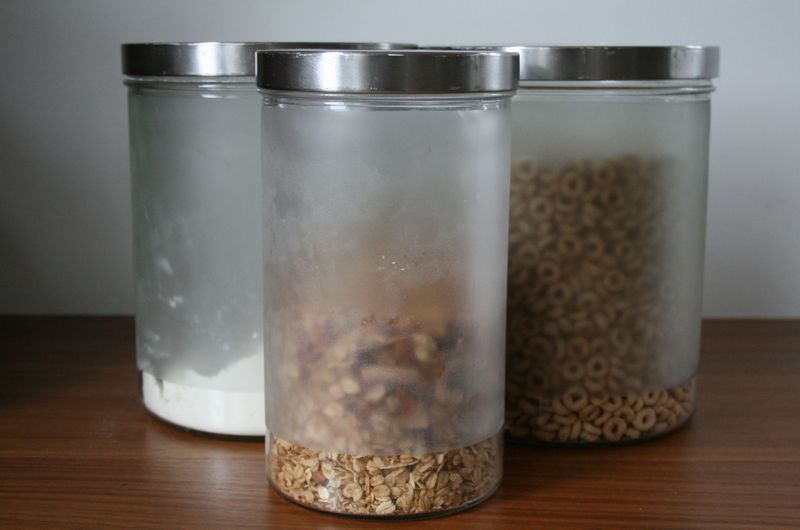
Photo by Sara Dickerman
I also I have a small collection of vintage glass refrigerator dishes that I use to store nibbly things like nuts and trail mix. They don’t really seal shut, and they make me a little nervous when they are all stacked up, but they do delight me.
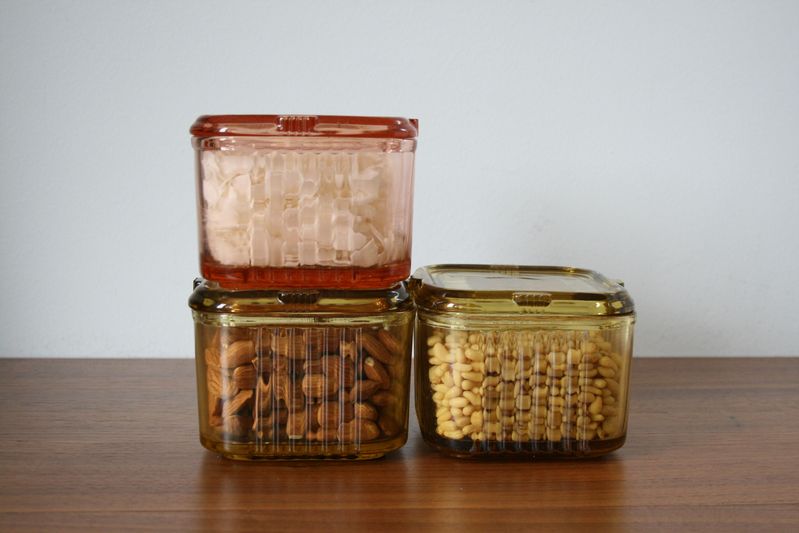
Photo by Sara Dickerman
Storing the storage
Storage is the worst for food containers, there are no two ways about it. If you can get them in a drawer instead of shelves, they will drive you slightly less crazy, I think. I favor getting many containers of a single size so that searching for lids is a little less traumatic. And don’t store your containers with the lids on: Not only does that eat up space, but they aren’t always 100% dry when they are put away and sealing up a humid container is just a bad move. You can corral the lids in baskets or larger containers so that they are easy to locate.
Getting stains out of plastic containers
Besides environmental concerns, plastic is just harder to clean than glass and stainless. You can try to remove tomato stains or curry powder haze with Alka-Seltzer or by rubbing it with lemon juice and sitting overnight, but rather than tell you how to get the orange tint out of plastic containers, I’ll encourage you to choose other materials when you’re storing very smelly or colorful food items.
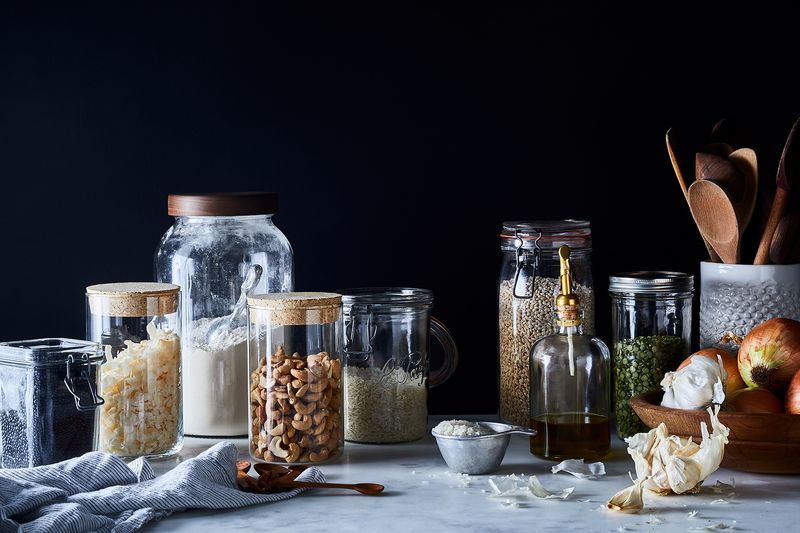
by Sara Dickerman
What are your favored kitchen storage containers, and how do you keep everything neat and clean? Share your best tips with us below!
(via Food52)

